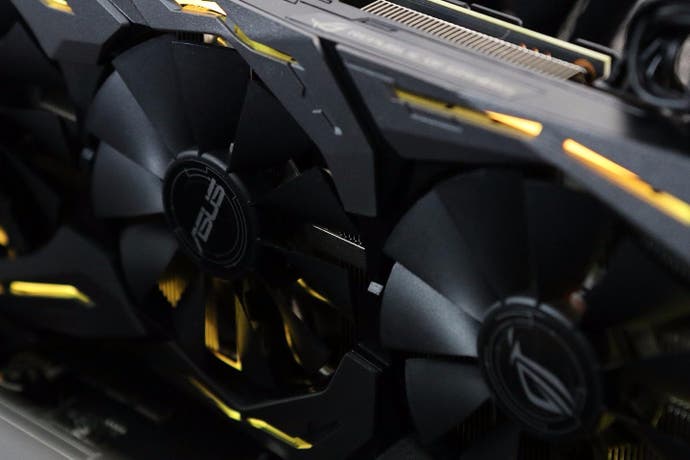Asus Strix GTX 1070/GTX 1080 O8G review: high-end SLI tested
Are two GPUs really better and cheaper than one? Dual high-end Nvidia cards take on Titan X Pascal.
This is becoming a habit. We don't usually review aftermarket graphics cards, but when Asus came to us offering to check out the high-end OC versions of their GTX 1070 and GTX 1080, we couldn't resist. Clinching the deal was the fact that two of each were delivered, meaning we could compare both of Nvidia's GP104-based graphics cards in SLI with the GP102-based Titan X Pascal - the fastest single-chip GPU money can buy. In theory, both of them should be able to best Nvidia's top-tier card and by extension, we should be able to get even better 4K performance.
Once the preserve of multi-thousand pound monitors, 4K is now becoming readily accessible at easy to absorb price-points. To put things into perspective, the 40-inch Samsung KU6400 we reviewed last week ranks as one of the best desktop monitors we've used - you retain an extreme pixel density, but you get some serious real estate to work with. Combine a screen like this with the Titan X Pascal and you get a stunning PC experience. GTX 1070 in SLI - in theory - looks particularly compelling, offering more performance than the Titan X, at just 63 per cent of the price.
However, it is fair to say that these more expensive Asus Strix cards are rather special. We're looking at the 08G versions - large, tri-fan cards with 'Aura' RGB lighting, deluxe back plates and ultra-quiet operation. Out of the box, these things overclock to 1975-2025MHz depending on load, meaning that you're getting pretty much everything out of the GP104 core without having to worry about stability. And on top of that load temperatures remain in the early 60 degrees Celsius range. This makes the 08G cards the coolest GP104 cards we've seen. Cheaper A8G cards are available that cost significantly less though, but virtually all GTX 1070s and 1080s tend to hit the core limit at 2.05GHz - which is worth bearing in mind here.
Also of interest with these cards is the tweaked port arrangement. Typically, Nvidia clusters three DisplayPorts with one HDMI 2.0 and a dual-link DVI output. Asus drops one of the DPs, instead opting for two HDMIs - and that's a good thing for those with VR headsets and a UHD screen. Power inputs are limited to one eight-pin socket on the GTX 1070 (more than enough) and a perhaps OTT six/eight-pin arrangement on the 1080. To the best of our knowledge, Nvidia has locked down over-volting on Pascal, so pushing GP104 beyond 2.05GHz is entirely down to the silicon lottery.
Similar to competitor cards, there are three performance profiles available with the Strix cards, accessed via a tool called GPU Tweak 2, which also controls the 'aura' RGB lighting. OC mode is the standard setting, giving us that circa 2GHz clock with no further tweaking necessary, while gaming mode drops back a couple of percentage points. Silent mode pulls back clocks still further in order to maintain a more discrete profile. Typically, this brings performance down on par with reference clocks, but we found that both Strix 1070 and 1080 still marginally out-perform the Founders Edition cards even with throttled back horsepower. This may change in more thermally constricted environments, however, as the emphasis here is always on discrete acoustics.
Overall then, the O8G Strix cards are superb pieces of engineering but there is an irony in that products geared towards high-end overclockers are actually of more use to those who don't overclock at all. At most, you can only extract a further 50-75MHz out of the core before stability issues intrude - and those additional clocks will have very little impact on the gameplay experience. You can boost memory on all of these cards by between 600-700MHz (we recommend staying at the former) and the increase in bandwidth certainly helps, but to be frank, this is a tweak that should be possible on every GTX 1070 or GTX 1080 out there.
It all serves to emphasise that the days of overclocks in excess of 20 per cent from the Maxwell days are all but over, and of course, there's no chance of even the most high-end GTX 1070 matching 1080 performance in the way that GTX 970 could draw on level with 980. And with that circa 2.05GHz hard and fast limit in place on GP104 products, there are strong arguments that you don't really need beautifully high-end products like this one.
| GTX 1070 AC Unity 1440p | Asus Silent | Asus Gaming | Asus OC | Asus +50/+600 OC |
|---|---|---|---|---|
| Low/Avg Frame-Rate | 43.0/53.4 | 44.0/54.4 | 44.0/54.5 | 47.0/59.6 |
| SLI Low/Avg Frame-Rate | 79.0/102.0 | 79.0/102.8 | 79.0/103.8 | 88.0/109.5 |
| GTX 1080 AC Unity 1440p | Asus Silent | Asus Gaming | Asus OC | Asus +50/+600 OC |
|---|---|---|---|---|
| Low/Avg Frame-Rate | 54.0/66.4 | 55.0/68.2 | 56.0/69.5 | 57.0/70.7 |
| SLI Low/Avg Frame-Rate | 80.0/121.0 | 81.0/122.5 | 81.0/124.7 | 99.0/130.9 |
The core of our work here is going be in assessing SLI performance, but before we do that, we should talk about the practicalities of the set-up. Nvidia has all but abandoned multi-GPU set-ups in excess of two cards (rightly so in our opinion), and has introduced a new SLI bridge that apparently solves bandwidth issues with the old ribbon connectors. You need the right bridge for your motherboard, and choosing the right one is all about the spacing between the main two PCI Express slots on the board.
And this leads us on to another practicality with SLI - thermal management. The cooling assembly used by the likes of Asus, MSI and EVGA pumps heat out into the case, as opposed to the reference designs that propel heat out of the rear of the PC. A general rule of thumb is that custom coolers provide huge benefits in single-card set-ups, but SLI sees tangible benefits from the blower-style thermal solutions typically employed on reference cards. And we definitely saw the results in our tests. With GTX 1070, the second GPU - with plenty of cool air surrounding it - operated at 58 degrees Celsius (a remarkable result for a 2GHz GPU). However, the first GPU, with limited airflow ran a full 10 degrees hotter.
A sub 70 degree result is still exceptional, but generally speaking, our advice would be to space cards with Strix-style coolers as far apart as possible - not so easy on a standard mainstream Z170 motherboard. Typically the higher-end enthusiast boards have more flexibility there. Regardless, the Strix cards still worked beautifully in SLI on our MSI Gaming M7 board, we got nowhere near thermal limits (Nvidia Pascal processors tend to start throttling back around 82 to 83 degrees), and the results were excellent.
| 3840x2160 (4K) | GTX 1070 | GTX 1070 SLI | GTX 1080 | GTX 1080 SLI | Titan X Pascal |
|---|---|---|---|---|---|
| Assassin's Creed Unity, Ultra High, FXAA | 27.7 | 56.1 | 35.4 | 67.5 | 43.1 |
| Ashes of the Singularity, Extreme, 0x MSAA, DX12 | 50.0 | 65.2 | 60.8 | 81.8 | 63.7 |
| Crysis 3, Very High, SMAA T2x | 33.5 | 54.8 | 42.3 | 66.2 | 50.0 |
| The Division, Ultra, SMAA | 33.4 | 52.8 | 41.0 | 63.9 | 49.6 |
| Far Cry Primal, Ultra, SMAA | 35.4 | 64.2 | 44.6 | 79.6 | 54.7 |
| Rise of the Tomb Raider, Very High, High Textures, SMAA, DX11 | 38.8 | 70.1 | 50.7 | 86.6 | 62.3 |
| The Witcher 3, Ultra, Post AA, No HairWorks | 39.5 | 68.4 | 50.0 | 82.2 | 63.2 |
We'll start with 4K, where we see some fascinating results. The performance benchmark for the fastest single-chip solution money can buy is set by Nvidia's stupendous Titan X Pascal, and the benchmarks are revealing. In every case, GTX 1070 SLI beats the Titan. The margin may well vary from title to title, but the end result is clear - there's a cheaper route to achieving locked 4K, 60fps gameplay with minimal settings compromises than investing so much in the top-tier Titan. GTX 1070 SLI achieves similar results to Titan X on the hugely demanding Crysis 3, but other titles see big improvements. Rise of the Tomb Raider yoyos between 45-60fps on max settings at 4K during gameplay - GTX 1070 SLI is much more stable, with far less fluctuation from the target 60fps.
Perhaps not surprisingly, GTX 1080 in SLI powers on still further, generally offering 30 per cent more performance than Titan X, rising up to 57 per cent on games that scale exceptionally well, like Assassin's Creed Unity. And this all comes from a base asking price pretty much on par with the Titan's cost. Obviously the arrival of GTX 1080 Ti will upset that balance somewhat, but regardless, GTX 1080 SLI throws up exceptional levels of power. Connected up to a 4K screen, the visual payback from titles like Rise of the Tomb Raider and Assassin's Creed Unity is simply epic.
The drawbacks? They're the same as they've always been. The Division still exhibits some profound micro-stutter issues - you get the frame-rate boost on paper, but the actual real life experience is not great. Curiously though, The Witcher 3 used to exhibit the exact same problems and this has now been resolved. And of course, there's the fact that some titles simply don't support SLI, or that the implementation arrives some time after launch. We played Gears of War 4 at 4K60 on the Titan X Pascal and had a great time. Were we to do the same with our 1070/1080 SLI set-ups, that second card would be sat there doing nothing.
| 2560x1440 (1440p) | GTX 1070 | GTX 1070 SLI | GTX 1080 | GTX 1080 SLI | Titan X Pascal |
|---|---|---|---|---|---|
| Assassin's Creed Unity, Ultra High, FXAA | 54.5 | 103.8 | 69.5 | 122.5 | 79.4 |
| Ashes of the Singularity, Extreme, 0x MSAA, DX12 | 64.6 | 81.6 | 75.3 | 91.8 | 83.7 |
| Crysis 3, Very High, SMAA T2x | 70.0 | 111.1 | 89.1 | 131.8 | 102.8 |
| The Division, Ultra, SMAA | 59.7 | 91.1 | 73.5 | 108.0 | 84.8 |
| Far Cry Primal, Ultra, SMAA | 65.0 | 99.3 | 80.8 | 96.0 | 96.3 |
| Rise of the Tomb Raider, Very High, High Textures, SMAA, DX11 | 74.2 | 108.4 | 96.5 | 120.5 | 114.4 |
| The Witcher 3, Ultra, Post AA, No HairWorks | 70.5 | 112.2 | 89.1 | 126.3 | 108.3 |
Results begin to close up a little at 1440p in several respects. While there's still a tangible gain over single card solutions, several titles begin to see performance equalise whether we're using Titan X Pascal, or either GTX 1070 or GTX 1080 SLI solution. Rise of the Tomb Raider DX11 and Far Cry Primal are perhaps the most obvious examples, demonstrating that the further down the resolution scale we move, the less effective SLI generally becomes - we're hitting bottlenecks elsewhere within the system. A potential way forward is accept the lower frame-rates and stack up on GPU features instead, where scalability should improve. We tend to use cheap anti-aliasing solutions in our GPU tests, but MSAA would be an option here.
The games that generally tend to scale well still do so, however. Perennial SLI favourite Assassin's Creed Unity really does see some terrific gains no matter what we throw at it. Even Crysis 3 hands in some impressive returns. However, the fact that we're approaching system limits also throws up some interesting metrics - scalability improves on the lower-end GTX 1070. Looking at the benchmarks in context via our FCAT analysis demonstrates that with GTX 1080 and to a lesser extent Titan X Pascal, we simply have too much GPU power, meaning we hit a system bottleneck. GTX 1070 SLI scales up to that limit pretty closely, whereas GTX 1080 slams straight into a wall. SLI can also cause some 'weirdness' too. For example, Far Cry Primal actually sees a regression in performance on GTX 1080, while GTX 1070 SLI works fine. The same thing happens at 1080p too.
The bottom line seems clear though - GTX 1070, 1080 and Titan X Pascal all produce excellent results at 1440p in single-card configurations, once you've adjusted settings to match your hardware. The idea with SLI is that you could in theory service a 120 or 144Hz display, but the reality is that on modern games at least, draw-heavy areas top out at 90-100fps. It's a nice boost but questions need to be asked about the value proposition here. Perhaps waiting for GTX 1080 Ti to come along seems like a better bet if GTX 1080 isn't doing it for you.
| 1920x1080 (1080p) | GTX 1070 | GTX 1070 SLI | GTX 1080 | GTX 1080 SLI | Titan X Pascal |
|---|---|---|---|---|---|
| Assassin's Creed Unity, Ultra High, FXAA | 84.3 | 139.9 | 105.2 | 150.4 | 119.2 |
| Ashes of the Singularity, Extreme, 0x MSAA, DX12 | 71.4 | 87.9 | 84.9 | 90.1 | 87.6 |
| Crysis 3, Very High, SMAA T2x | 111.3 | 163.9 | 137.5 | 179.4 | 153.9 |
| The Division, Ultra, SMAA | 83.6 | 124.5 | 101.4 | 143.0 | 117.9 |
| Far Cry Primal, Ultra, SMAA | 91.8 | 98.7 | 113.3 | 90.4 | 132.2 |
| Rise of the Tomb Raider, Very High, High Textures, SMAA, DX11 | 111.9 | 137.6 | 141.9 | 129.8 | 160.6 |
| The Witcher 3, Ultra, Post AA, No HairWorks | 98.3 | 129.1 | 119.4 | 130.9 | 137.6 |
Finally, we have 1080p metrics, and we've included these for the two reasons - firstly, full HD remains the most popular gaming resolution according to the Steam hardware survey, and secondly, once again, there are a lot of high frequency refresh displays out there where, in theory, an SLI set-up could really help.
However, the bottom line is clear - we hit system limits fast. It's true that you do seem some scalability in performance, but obviously the average frame-rates are depressed somewhat. But the key here is that we are talking about the increase as an average, suggesting a sustained performance boost across the gameplay. Watch the performance video above and the reality becomes clear - frame-rates jump high then crash down low. There is little in the way of a uniform boost in most titles and much of your GPU power is wasted here.
There's further food for thought as we look at lowest recorded frame-rates. With the exception of Ashes of the Singularity, GTX 1070 under the most immense loads always remains above 60fps in our benchmark titles. There's still further sustained scalability by moving up to a single GTX 1080, but beyond that the bottlenecks can hit hard - whether we're using Titan X Pascal or SLI.
Asus Strix GTX 1070-O8G/1080-O8G SLI - the Digital Foundry verdict
The Asus Strix cards we tested were beautifully designed, exceptionally well put together and they overclocked like demons out of the box with zero user effort required. However, in common with the MSI GTX 1080 Gaming Z we tested a while back, gains to core clock beyond the factory OC are limited, with the biggest boosts coming from overclocking VRAM - though results there will obviously very on the title you're playing. And with that hard and fast limit in place, much cheaper examples of the card can effectively reach the same speeds - though perhaps not with the exceptional thermal and acoustic performance seen here.
SLI testing proved to be a fascinating experiment, but it's safe to say that performance can vary wildly at lower resolution and it's really at ultra HD (or with multi-monitor support) where SLI really starts to make sense. Going into our tests, we expected limited scalability, with Titan X Pascal still taking point - if not in terms of frame-rates, certainly in terms of stability. However, The Division aside, GTX 1070 did an excellent job of matching and exceeding Titan X performance. It's interesting to note though, that GTX 1080 SLI only adds around 10-15fps at 4K - it's a very useful cushion to have, but similar results can be achieved by careful settings management on a 1070 SLI set-up without too much of a hit to image quality.
And with that in mind, of both the SLI configurations tested, it's GTX 1070 that sort of makes the most sense. You get the GPU power required to hit 4K at 60fps in a great many demanding titles, it's the cheapest Pascal SLI set-up available and clearly offers the best balance of price vs performance. At 4K with a 60fps limit in place, the actual experience offered by 1070 and 1080 in SLI was remarkably close, and on key test titles like Rise of the Tomb Raider and Crysis 3, the vast amount of extra cash you'd need for GTX 1080 SLI actually translated into little more than improved anti-aliasing and an improved grip on the target frame-rate. We're left wondering what Titan X Pascal or a prospective GTX 1080 Ti SLI could actually offer when even 1070 SLI is so, so good.
But of course, it's the spectre of the inevitable upcoming GTX 1080 Ti (we hope to see it by January) that should make anyone think very carefully about a prospective SLI purchase in the short term. We can safely assume it'll be cheaper than any Pascal SLI configuration in the here and now, and using Titan X as a rough performance guideline, the price vs performance outlook for high-end users should be impressive. And on top that, its arrival may also see a price-cut for the GTX 1080. But beyond the theoreticals, the reality is this - 4K gaming at 60fps is terrific with the right display, and while Titan X Pascal is the current best choice in terms of single-chip GPUs, even GTX 1070 SLI still packs one hell of a punch.





















